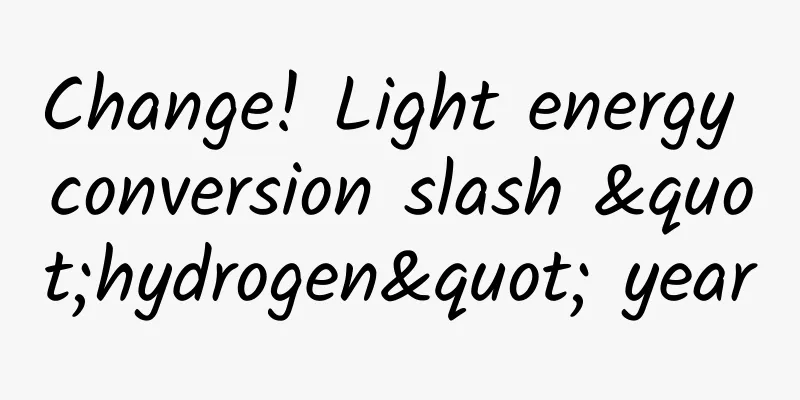To make snow, you first need to plant snow. How can you create snow out of nothing? How do snow cannons do this?

|
The Winter Olympics started snowmaking, which made more people know about snow cannons. However, snowmaking requires sowing "snow seeds". Where does "snow seeds" come from? How do snow cannons make snow? Snow sports (Photo source: new.qq.com) The “template” for artificial snowmaking Natural snowfall is a slow process, and its formation is based on tiny ice crystals, which are formed by the condensation or sublimation of water vapor on the crystal nucleus (condensation nucleus). The crystal nucleus here is what we often call "snow seed", which can be a grain of dust or a grain of pollen... As small ice crystals float in the atmosphere, more water particles condense onto the ice crystals and slowly form snowflakes. If the weather is cold enough, the snowflakes will slowly fall to the surface of the earth as they become heavier. Of course, if the ground temperature is high, the falling snowflakes will also melt. What would happen if there were no crystal nuclei? In short, small ice crystals could not form, and without small ice crystals, snowflakes could not form. It turns out that pure water droplets will not freeze at the freezing point, and if the temperature continues to drop, they will be in a supercooled state. In fact, the freezing (nucleation) of pure water requires a low temperature of about -40°C. However, this supercooled state is unstable. As long as it is triggered by a condensation nucleus such as a little dust, the water droplets will form small ice crystals without dropping to -40°C. Formation of natural snow (Image source: Reference [2]) The principle of snow cannons is actually to simulate the formation process of natural snow. The question is, how to "plant snow" without "snow seeds"? There is no "refrigerant" that can be made by yourself! However, the production of "refrigerant" is not "out of nothing", but is made by the rapid freezing of atomized water droplets. The driving force behind “water turning into snow” From an energy perspective, the driving force behind “water turning into snow” is “cold”! For snow cannons to make snow, the transition from liquid water to snow crystals involves a phase change process, so a certain amount of heat needs to be removed from the liquid water to complete the process. The heat mentioned here includes sensible heat and latent heat. Snowmaking machine (CCTV News screenshot) We can simplify the heat exchange process into two processes. The first is to lower the temperature of liquid water to 0℃. For every 1℃ lowering of the temperature of each kilogram of liquid water, 4.2 kilojoules of heat need to be transferred. The second is to convert 0℃ liquid water into 0℃ ice crystals. For every kilogram of liquid water, 336 kilojoules of latent heat need to be transferred. Of course, considering the supercooling of the water droplets and the loss of cold, more heat actually needs to be transferred out. The question is, who is responsible for transferring the heat? There are two main forces that transfer heat: one is the expansion of compressed air due to decompression and the other is the convection and evaporation of atomized water. How does a snow cannon make “snow seeds”? The nucleator (nucleator) distributed around the top of the snow cannon's spray barrel is the core component for rapidly manufacturing crystal nuclei. Generally, snow cannons are connected to compressed air and high-pressure water with pipes. After the compressed air and high-pressure water are mixed, they are sprayed out through the nozzle of the nucleator. The compressed air quickly atomizes the water into small droplets, and quickly cools it down and freezes it into tiny crystal nuclei. This is the process of snow cannons quickly making and spreading "snow seeds". Why can the instantaneous expansion of compressed air generate refrigeration? In the mid-19th century, famous physicists Joule and Thomson discovered that when a certain gas passes through a throttle valve, a sudden change in pressure will occur, and the temperature of most gases (except hydrogen and helium) will drop. This is the famous Joule-Thomson effect. Snow cannons use this effect to make snow seeds. This effect is also widely used in many aspects such as gas cooling and liquefaction. The air conditioners and refrigerators that have been integrated into our lives also use this effect in their refrigeration cycles. Next to the nuclear nozzle on the top of the snow cannon barrel, there are many snow-making nozzles, which spray high-pressure water. After being atomized by the nozzle, this high-pressure water is also thrown into the air. The evaporation of water molecules on the surface of these small water droplets in the air will take away a lot of heat, thus cooling the water droplets themselves. The fusion of these cooled water droplets with the crystal nuclei will form more small ice crystals... The freezing of water droplets on small ice crystals and the combination of ice crystals will cause the ice crystals to grow rapidly, eventually forming "snowflakes" that fall to the ground. Snowmaking doesn’t require “right time”? Snow cannons are used to make snow mechanically, which is basically done in an artificial environment. Does artificial snowmaking also require "weather"? In fact, snow cannons only partially simulate the formation process of natural snow. The growth trajectory of outdoor artificial snow from the crystal nucleus can be said to be completed in the atmospheric environment. Therefore, artificial snowmaking also requires the help of "weather" conditions. It is generally believed that artificial snowmaking requires "cold and dry" weather conditions. The "cold" here refers to the low atmospheric temperature, which can improve the quality and output of snowmaking. The "dry" here refers to the low relative humidity of the atmospheric environment, which is conducive to the evaporation of water on the surface of water droplets in the snowmaking microenvironment, so that the cooling effect will be more obvious. Imagine that if the relative humidity of the atmosphere reaches 100%, it means that it can no longer accept water vapor. Therefore, the water on the surface of the water droplets in the snow-making microenvironment can no longer evaporate. Unless the temperature of the atmosphere is extremely low, the water droplets can no longer continue to cool, which will affect the growth of snow crystals. Wet-bulb thermometer (Image source: [5]) In the practice of artificial snowmaking, "wet bulb temperature" is an indicator with important reference value. When measuring the wet bulb temperature, you can wrap the temperature-sensing part of an ordinary thermometer with wet gauze and immerse the lower end of the gauze in a water-filled container, which will become a wet bulb thermometer. Place it in a ventilated place, and the reading of the thermometer is the wet bulb temperature. Based on this, we can select an appropriate time window for artificial snowmaking to improve the efficiency and quality of snowmaking. Is natural snow better than artificial snow? From water vapor in the atmosphere to the formation of ice crystals, and then to the growth of ice crystals and the formation of snowflakes... the growth trajectory of natural snow truly records a lot of information about atmospheric environmental factors. The snowflakes of natural snow are mostly branch-shaped hexagonal ice crystals, which are light and soft and easily melt when they fall to the ground. Snow crystal shape changes with temperature and supersaturation (see watermark for image source) Although artificial snow replicates the formation process of natural snow, its life cycle is greatly shortened due to the use of physical means, causing water droplets to freeze in an instant and grow rapidly. Although artificial snow is essentially the same as natural snow, its shape is basically spherical and there are no branch-like hexagonal ice crystals. The difference between natural snow and artificial snow observed under a microscope (Image source: https://newtoski.com/snowmachine-vs-natural-snow/) However, it is generally impossible to tell whether the ski tracks are made from artificial snow or natural snow. If you want to say which is better, artificial snow or natural snow, if it is used for skiing, artificial snow is better than natural snow. Artificial snow is more resistant to sunlight than natural snow. Natural snow is easy to melt due to its high water content, so it cannot withstand direct sunlight; while artificial snow generally has a lower water content, so it is not afraid of sunlight. Under the same temperature conditions, artificial snow with good snow quality is 5-6 times more resistant to melting than natural snow. Artificial snow is small and looks powdery. Because of its more compact spherical structure, its density is greater than that of natural snow. The density of natural snow is about 328 kg/m3, while the density of artificial snow is as high as 856 kg/m3. Artificial snow is easier to be pressed, and the snow surface after rolling will be harder and have less friction. Since artificial snow is not easy to melt under sunlight and high temperature, spraying a small amount of water on the snow surface can make it white as before. However, the easy melting of natural snow makes it difficult to maintain its white color. The "Science and Technology Winter Olympics" project has put forward clear requirements for the research and development and application demonstration of snowmaking machines. Snowmaking machines and their nozzles and nuclear devices should meet the goal of achieving normal snow production at a temperature of 0°C and a humidity of 50% under different geographical and climatic conditions, and the snow quality must meet the standards of the International Ski Federation. References [1] Li Jing. Impact of meteorological conditions on artificial snow activities. Progress in Meteorological Science and Technology, 7(1)-2017. [2] Encyclopædia Britannica, Inc., translated by Chen Yiquan. Weather and Climate (Britannic Illustrated Science Series), China Agriculture Press, March 2013. [3] Yang Lixiang. Research and analysis of snowmaking machine, Mechanical and Electrical Product Development and Innovation, Vol. 23, No. 3 (May 2010). [4] https://nsidc.org/cryosphere/snow/science/formation.html [5]https://www.snowathome.com/pdf/wet_bulb_chart_celsius.pdf |
>>: Beware of "Parrot Fever"! A man slaughtered a chicken and almost died
Recommend
IPTV and OTT: A protracted battle between government control and public demand on the big screen
Since 2012, IPTV has experienced the "wild g...
A growth activity idea and plan
For Internet people who are engaged in user growt...
How to create a hit product on Xiaohongshu? Xiaohongshu’s hot-selling guide!
As a gathering place for the new generation of co...
[In-depth Revelation] Analysis of Internet Financial Product Operation Strategies!
The main product model of Internet finance is rel...
Geek Park: Alibaba Cloud and Huawei Cloud were successfully selected for the 2023 "China Innovation Force 50 List (InnoForce 50)"
Recently, Geek Park, China's largest innovato...
99% of traders have paid the price for these 5 pitfalls in live streaming sales!
Luo passed the baton of exceeding 200 million GMV...
It's a big hit! Hundreds of thousands of people watch this video every day at the subway station here...
In the past two days, Fuzhou residents Have you n...
Is eating Cordyceps sinensis useful for cancer?
I believe everyone knows the power of Cordyceps a...
WeChat Mini Program fission marketing, how to play the mini program fission distribution system?
General mini-program e-commerce malls can only co...
When buying traffic for information flow advertising games, take care of these 4 factors to increase the payment rate!
There are always people living in a higher dimens...
Is the prediction of "The Three-Body Problem" coming true? The Milky Way may be losing dark matter
We all know that the ending of "The Three-Bo...
A Simple Guide to Mobile Web Design for Web Designers
As early as a few years ago, the data traffic of ...
How easy is it to “misjudge” yourself?
© neurofeedback Leviathan Press: There is a sayin...
How to write an activity planning proposal? Here are 4 tips for you!
If your boss is a fanatic about offline and onlin...
How to place advertisements in Juliang Qianchuan live broadcast room
Juliang Qianchuan builds video or live broadcast ...









